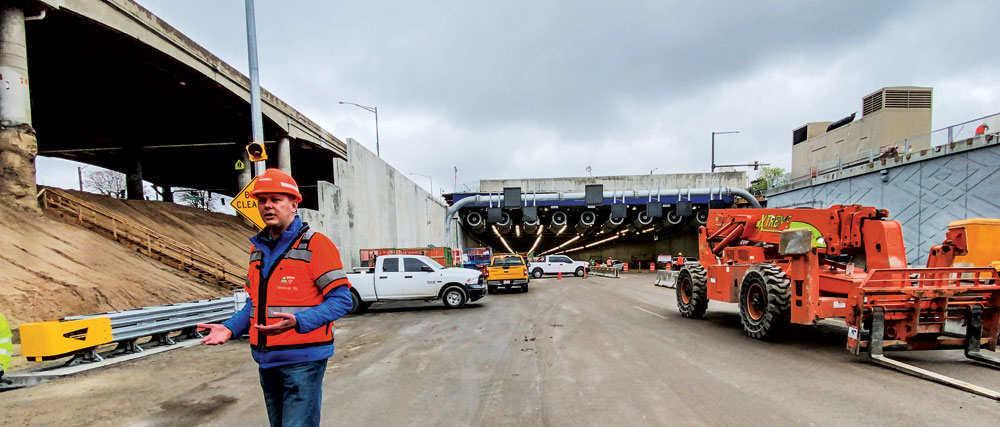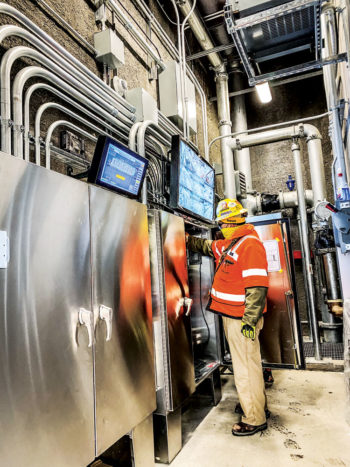
The 1,000-foot tunnel has nine giant fans to remove exhaust and smoke. The tunnel also has heat sensors, closed-circuit cameras, and a giant sprinkler system that can drop 3,500 gallons of water a minute in case of fire. The LED lights are attached to an external sensor so the light level inside adjusts to match the daylight outside.
The Central 70 Project celebrated a major milestone at the end of May when it opened up a new two-mile stretch of I-70 that is 30 feet below ground level. The new section, from Colorado to Brighton Blvds. is considered the “crown jewel” of the entire 10-mile highway reconstruction project. While most of this lowered section is open to the sky, a 1000-foot section, from Columbine to Clayton Sts., will be covered and a 4-acre park will be constructed on top.
——— View video of Bob Hays taking about the project ———

Project Director Bob Hays stands in the newly constructed westbound lanes for I-70, with the old highway viaduct above and to his left. Both east and westbound traffic will utilize these lanes while the viaduct is demolished and the eastbound lanes are constructed.
The public got its first close-up look at the project on May 15 when the Colorado Department of Transportation (CDOT) hosted a half-mile walking tour of the new construction. Some 3,000 residents strolled under the tunnel and viewed 25 exhibits with information about the $1.3 billion project and about the history of the surrounding neighborhoods of Globeville and Elyria-Swansea. Those communities had been physically divided when the I-70 viaduct was constructed. The 4-acre park was designed to help re-unify those neighborhoods while providing a place for recreation and social events. Pedestrians were also able to look at the artwork on the concrete walls which was designed with input from community meetings. The theme of the artwork is “people, places, and culture” and is designed to celebrate the culture of immigrants from more than 50 nations who live in the area.

The theme for the new I-70 wall panels, “people, places and culture” emerged from community workshops. The panels celebrate immigrants from more than 50 nations who raised families and started businesses in the Globeville-Elyria-Swansea communities. The panels adjoin the construction and honor the traditions and events of these communities with images of food, dance and art.
One week after the pedestrian “open house,” I-70 from Washington Street to I-270 was completely shut down for just over 48 hours while crews prepared for what CDOT called the “Mile High Shift” to the lowered section. Cars began using the brand-new stretch of highway on Monday, May 24th and for the next 18 months, both eastbound and westbound traffic will travel in these newly opened six lanes. The adjacent 57-year old viaduct that formerly carried the highway will be torn down and additional lowered lanes will be constructed in its place. When the project is completed, scheduled for the end of 2022, eastbound traffic will be routed into the former viaduct section while westbound traffic will have exclusive use of the lanes just completed.

This mechanical room, at the entrance to the tunnel, controls the state-of-the-art systems designed to monitor and respond to any emergencies that might arise in the tunnel.
Project director Bob Hays says he’s proud of all the safety systems that have been built into the new construction. The two-mile lowered stretch has a complex drainage and pump system to get rid of rain water. “It’s capable of handling a 100-year flood event, if that would ever come to fruition,” said Hays. The 1,000-foot tunnel has a full complement of automated safety systems including 9 giant fans to remove exhaust and smoke, heat sensors, closed-circuit cameras, and a giant sprinkler system that can drop 3,500 gallons of water a minute in case of fire. The tunnel also has LED lights attached to an external sensor so the light level inside adjusts to match the daylight outside. “We don’t want drivers to have a shock factor as they drive under the cover structure,” said Hays.
Perhaps the most difficult part of project is still to come: dismantling the old viaduct. Because it is located directly between the newly-constructed highway to the north and a neighborhood to the south, Hays says it will necessitate a “surgical process.” Crews will use saws to cut out portions of the old highway, then carefully lower them down so they can be ground up and hauled away. Giant netting will be erected to prevent any debris from damaging nearby structures and air quality will be monitored for any heavy metals that might be released. “The project is going to take great care in not damaging the new infrastructure or the adjacent businesses and homes,” says Hays.
Once the viaduct has been demolished and the new lanes have been completed, construction of the 4-acre park on top of the tunnel will begin. It will hold a full-size soccer field and a small outdoor amphitheater, along with a playground area, and room for food trucks or a farmers’ market.

A temporary wall of dirt was constructed to support the old viaduct while the I-70 westbound lanes and newer viaducts (blue one shown here) were built. Both the old viaduct and dirt wall will be removed to make room to construct the eastbound lanes.
Hays says the highway project has stayed on schedule, despite some weather challenges and the discovery of seven fossils. The most notable were two molars of a camel-like creature likely from the Pleistocene age. A paleontological company was contracted to monitor and collect such findings. The fossils will ultimately be given to the Denver Museum of Nature and Science.
Front Porch photos by Christie Gosch

An artist rendering of the 4-acre park that will be constructed on top of the 1,000-foot tunnel stretching from Clayton to Columbine Street. Rendering courtesy of CDOT, Central 70 project




0 Comments